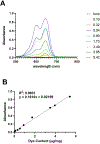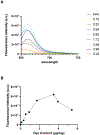Optimizing the performance of silica nanoparticles functionalized with a near-infrared fluorescent dye for bioimaging applications
- PMID: 38631329
- PMCID: PMC11216106
- DOI: 10.1088/1361-6528/ad3fc5
Optimizing the performance of silica nanoparticles functionalized with a near-infrared fluorescent dye for bioimaging applications
Abstract
Modified fluorescent nanoparticles continue to emerge as promising candidates for drug delivery, bioimaging, and labeling tools for various biomedical applications. The ability of nanomaterials to fluorescently label cells allow for the enhanced detection and understanding of diseases. Silica nanoparticles have a variety of unique properties that can be harnessed for many different applications, causing their increased popularity. In combination with an organic dye, fluorescent nanoparticles demonstrate a vast range of advantageous properties including long photostability, surface modification, and signal amplification, thus allowing ease of manipulation to best suit bioimaging purposes. In this study, the Stöber method with tetraethyl orthosilicate (TEOS) and a fluorescent dye sulfo-Cy5-amine was used to synthesize fluorescent silica nanoparticles. The fluorescence spectra, zeta potential, quantum yield, cytotoxicity, and photostability were evaluated. The increased intracellular uptake and photostability of the dye-silica nanoparticles show their potential for bioimaging.
Keywords: fluorescence imaging; photostability; silica nanoparticles; stöber method.
© 2024 IOP Publishing Ltd.
Conflict of interest statement
Conflicts of Interests
The authors declare no conflicting financial interests.
Figures








Similar articles
-
Photoactive hybrid nanomaterials: indocyanine immobilized in mesoporous MCM-41 for "in-cell" bioimaging.ACS Appl Mater Interfaces. 2009 Mar;1(3):678-87. doi: 10.1021/am800196r. ACS Appl Mater Interfaces. 2009. PMID: 20355990
-
Advancing fluorescence imaging: enhanced control of cyanine dye-doped silica nanoparticles.J Nanobiotechnology. 2024 Jun 19;22(1):347. doi: 10.1186/s12951-024-02638-7. J Nanobiotechnology. 2024. PMID: 38898529 Free PMC article.
-
Multi-dye theranostic nanoparticle platform for bioimaging and cancer therapy.Int J Nanomedicine. 2012;7:2739-50. doi: 10.2147/IJN.S28357. Epub 2012 Jun 1. Int J Nanomedicine. 2012. PMID: 22701319 Free PMC article.
-
Functionalized silica nanoparticles: a platform for fluorescence imaging at the cell and small animal levels.Acc Chem Res. 2013 Jul 16;46(7):1367-76. doi: 10.1021/ar3001525. Epub 2013 Mar 14. Acc Chem Res. 2013. PMID: 23489227 Review.
-
Fluorescent nanoparticles based on AIE fluorogens for bioimaging.Nanoscale. 2016 Feb 7;8(5):2471-87. doi: 10.1039/c5nr05051k. Nanoscale. 2016. PMID: 26478255 Review.
Cited by
-
Biomaterials Mimicking Mechanobiology: A Specific Design for a Specific Biological Application.Int J Mol Sci. 2024 Sep 26;25(19):10386. doi: 10.3390/ijms251910386. Int J Mol Sci. 2024. PMID: 39408716 Free PMC article. Review.
-
The evolution of immune profiling: will there be a role for nanoparticles?Nanoscale Horiz. 2024 Oct 21;9(11):1896-1924. doi: 10.1039/d4nh00279b. Nanoscale Horiz. 2024. PMID: 39254004 Free PMC article. Review.
References
-
- Siegel RL, Miller KD, Fuchs HE & Jemal A. Cancer statistics, 2022. CA. Cancer J. Clin 72, 7–33 (2022). - PubMed
-
- Hasan S. An Overview of Promising Biomarkers in Cancer Screening and Detection. Curr. Cancer Drug Targets 20, 831–852 (2020). - PubMed
-
- Niell BL, Freer PE, Weinfurtner RJ, Arleo EK & Drukteinis JS Screening for Breast Cancer. Radiol. Clin. North Am 55, 1145–1162 (2017). - PubMed
-
- Luo H. et al. Circulating tumor DNA methylation profiles enable early diagnosis, prognosis prediction, and screening for colorectal cancer. Sci. Transl. Med 12, eaax7533 (2020). - PubMed
MeSH terms
Substances
Grants and funding
LinkOut - more resources
Full Text Sources
